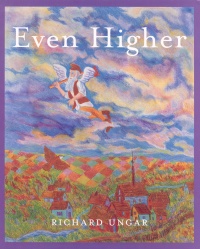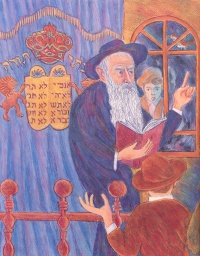| ________________
CM . . .
. Volume XIII Number 20 . . . .May 25, 2007 
 |
Even Higher.
Richard Ungar. Adapted from a story by I.L. Peretz.
Toronto, ON: Tundra Books, 2007.
32 pp., cloth, $22.99.
ISBN 978-0-88776-758-6.
Subject Headings:
Jews-Folklore.
Rabbis-Folklore.
Preschool-grade 2 / Ages 4-7.
Review by Harriet Zaidman.
** /4
|
| |
|

excerpt:
"Haven't you heard?" said Yossel, bending down to pick up another stone. "Each year, on the day before Rosh Hashanah, our rabbi is nowhere to be seen. It is as if he vanishes into thin air. At night he comes back, but no one sees where he goes during the day." Yossel flung the stone and it skipped twice before disappearing. "Do you know what everyone is saying, Reuven? That our beloved rabbi ascends to heaven and spends the day there, pleading with the Master of the Universe to forgive the sins of the people of Nemirov."
Rosh Hashanah, the Jewish New Year, is the most important holiday in the Jewish religious calendar. It begins a 10-day period (the Days of Awe) during which it is believed that God writes down the fate of each individual for the coming year. That fate can be changed before the end of Yom Kippur, the final day, by engaging in reflection and atonement for sins that have been committed.
It's the day before Rosh Hashanah in which Richard Ungar has set his third book, Even Higher. As with Rachel Captures the Moon and Rachel's Gift, the story is set in a Jewish shtetl of 19th century Eastern Europe. Even Higher is an adaptation of a story commonly known as "If Not Higher" by I. L. Peretz, one of the most respected Yiddish writers of that time.
A young boy, Reuven, accepts a dare to find out where the rabbi goes as the village prepares for the holiday. Rumours abound that the rabbi flies up to heaven to seek forgiveness for all the residents of the village. But Reuven knows that even learned men can't fly, and so he follows the rabbi from a distance.
To Reuven's surprise, the rabbi, a physically slight man, dresses for the day in the clothes of a simple woodcutter and leaves the village unnoticed. When he reaches the forest, he chops down a tree, breaks it into firewood and gathers it up. At every moment, Reuven expects the rabbi to head back to the village and the synagogue. Instead, the rabbi goes deeper into the forest to the hut of a poor, sick widow. He pretends to be selling the wood but tells the woman that she can pay him "when the Holy One provides" her with money.
The rabbi then slips back into town and returns to his work as spiritual leader of the congregation. Reuven's friends pester him for information, but Reuven keeps the rabbi's secret and learns the valuable lesson that to give of oneself without being asked and without recognition is the noblest form of giving.
The story is charming and instructive for children, and Ungar's adaptation is written at a level that can be read by capable children in the target age group. Parents and teachers will also find that the story has been structured well to engage children's minds - the mystery, the dare, the adventure, the truth, the lesson.
Much is made on the back cover and the inside back flap about the illustrations done by Ungar himself. He has studied at the Ontario College of Art and the Jerusalem School of Fine Art. His style reflects influence of Marc Chagall, the Russian-French impressionist whose paintings depicted the shaky life of European Jewry in Tsarist times.
 Unfortunately, Ungar's artistic efforts are, at best, competently amateur. His rendition of the human figure lacks the nuances that give a drawing, even a caricature, a level of presence and sophistication. The same must be said for his drawings of the village and daily life. Ungar uses swirls of pastel over the entire page, but his choice of colours makes some pages monotonous to look at. Shades of orange and purple dominate several pages, with no black lines or white spaces to separate the images and relieve the eye. White text is imposed on the artwork; it is difficult to read in several places - for example, the page with the widow's blanket, awash in swirls of green, blue, orange and purple, with the text on top.
Unfortunately, Ungar's artistic efforts are, at best, competently amateur. His rendition of the human figure lacks the nuances that give a drawing, even a caricature, a level of presence and sophistication. The same must be said for his drawings of the village and daily life. Ungar uses swirls of pastel over the entire page, but his choice of colours makes some pages monotonous to look at. Shades of orange and purple dominate several pages, with no black lines or white spaces to separate the images and relieve the eye. White text is imposed on the artwork; it is difficult to read in several places - for example, the page with the widow's blanket, awash in swirls of green, blue, orange and purple, with the text on top.
Considering the excellent skill level and the number of artists who draw for children's books today, it is surprising that Tundra did not reach out to find someone who could translate the words into a more beautifully illustrated picture book. Kudos to Ungar for keeping alive the work of classic writers such as Peretz and for making it accessible to children, but the presentation in a picture book matters, and this story would be better served in the hands of a better artist.
Recommended with reservations.
Harriet Zaidman is a teacher-librarian in Winnipeg, MB.

To comment
on this title or this review, send mail to cm@umanitoba.ca.
Copyright © the Manitoba Library Association. Reproduction for personal
use is permitted only if this copyright notice is maintained. Any
other reproduction is prohibited without permission.
NEXT REVIEW |
TABLE OF CONTENTS FOR THIS ISSUE
- May 25, 2007.
AUTHORS |
TITLES |
MEDIA REVIEWS |
PROFILES |
BACK ISSUES |
SEARCH |
CMARCHIVE |
HOME |

 Unfortunately, Ungar's artistic efforts are, at best, competently amateur. His rendition of the human figure lacks the nuances that give a drawing, even a caricature, a level of presence and sophistication. The same must be said for his drawings of the village and daily life. Ungar uses swirls of pastel over the entire page, but his choice of colours makes some pages monotonous to look at. Shades of orange and purple dominate several pages, with no black lines or white spaces to separate the images and relieve the eye. White text is imposed on the artwork; it is difficult to read in several places - for example, the page with the widow's blanket, awash in swirls of green, blue, orange and purple, with the text on top.
Unfortunately, Ungar's artistic efforts are, at best, competently amateur. His rendition of the human figure lacks the nuances that give a drawing, even a caricature, a level of presence and sophistication. The same must be said for his drawings of the village and daily life. Ungar uses swirls of pastel over the entire page, but his choice of colours makes some pages monotonous to look at. Shades of orange and purple dominate several pages, with no black lines or white spaces to separate the images and relieve the eye. White text is imposed on the artwork; it is difficult to read in several places - for example, the page with the widow's blanket, awash in swirls of green, blue, orange and purple, with the text on top.